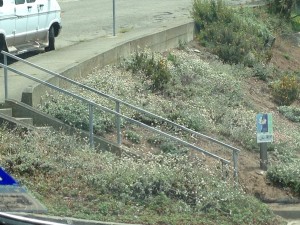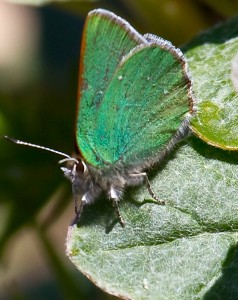
Photo: Liam O’Brien
The only person on the scene, missing, was the Xerces blue – almost what Bob Dylan sang.
A few days after I disclosed that I was leaving the RSPB, back in January 2011, I was in Oxford for the farming conference and had a coffee in a cafe with Martin Warren, the Chief Exec of Butterfly Conservation, one of the nicest nature conservationists that I know (is there anyone nicer?), and one of the most knowledgeable (is there anyone more knowledgeable?). When I said that I was heading off to the USA in search of extinct birds he told me about an extinct butterfly – the Xerces blue.
Today, in Cafe Flore on Market Street, San Francisco, I met Liam O’Brien who told me all about this extinct little blue butterfly. Liam is a great guy and I very much enjoyed his company, his knowledge, his humour and his turn of phrase. And just to get this fact out of the way, there aren’t many experts on butterflies who have played 1000 performances on Broadway (as Liam has – and in Les Mis of all things).
The Xerces blue was a species that lived in the coastal sand dunes of this area. It went extinct in the 1930s and 1940s because we destroyed its habitat – in other words the usual story.
In the 1780s, half of what is now San Francisco was sand dune. This covered much of what is now the Sunset district and Sea Cliff and Richmond. Looking down from the top of a hill, and San Francisco has plenty of hills remember, to the distant ocean it was difficult to picture this as a scrub-covered shifting dune system with little blue butterflies (amongst others) flying around in the sun.
The Xerces blue had a small range and we concreted it over. It’s difficult not to keep humming Joni Mitchell’s Big Yellow Taxi at this stage; ‘They paved paradise And put up a parking lot’. Yes, there were collectors taking specimens – Liam described it thus: ‘The polka-dot butterfly was the Willy Wonka Golden Ticket specimen’ but they wouldn’t have had anything to collect after WWII anyway.
The house where Ansel Adams grew up overlooked the spot, now having its habitat restored, where the last Xerces blue specimen was taken.
This is the only butterfly species (but was it a full species – it’s so hard to tell with flutterbys?) to have gone extinct in the USA, and it’s a different type of impact from that of the passenger pigeon. This butterfly was a restricted range species and was always rare (-ish).
Liam had a ‘good news’ story to tell too – in fact I think he had a whole bag full of stories to tell. The green hairstreak butterfly (same genus as ours – different species) used to fly around with the Xerces blue. Liam and others are making sure that it doesn’t disappear from the streets of Sand Francisco.

When I was looking down to the ocean over thousands of roofs where there used to be sand dunes, at my feet was a patch of native vegetation running down one side of the many pedestrian staircases mounting the hills. This provided a linear corridor of native vegetation for the green hairstreak. Liam and friends are persuading lots of people to do their bit and as we drove around I began to be able to spot the patches of Liam’s influence.
It’s a great idea to spread the habitat through the streets and with it the butterflies too. And it seems to be working.
I’m really glad that Martin told me about the Xerces blue (and that I listened and remembered) and I’m very grateful to Liam for being such a kind, amusing but knowledgeable host. I should also thank the Xerces Society (named after the butterfly, of course) whom I contacted and who put me in touch with Liam.
So, I saw as many Xerces blue as I, or anyone else, will see passenger pigeons, but I saw where they used to live, understood more about why they aren’t there any more and heard about the work going on to make sure that although some of the blue has gone out of the San Francisco world, the green will remain. So here’s another of Liam’s photos, of a green hairstreak, with which to end.

[registration_form]
Sad that the Xerces Blue was eliminated forever by the ‘paving of paradise and putting up of parking lots’. The number of North American butterfly species has been restored, though, by the recent discovery of a new species: Vicroy’s Ministreak Ministrymon janevicroy which occurs in Texas. Of course the Ministreak was there all along and its discovery is only because someone has noticed it is different to another similar species, the Gray Ministreak. I don’t know its conservation status but hopefully it can avoid the fate of the Xerces Blue.
Fascinating story about SF, never really understood it’s former past, sad we have to leave things behind and often forgotten about as we modernise and grow, one of the things that has struck me about your blog posts that despite their vast numbers no-one other then consevationist/birders seem to have any knowledge of the Passenger Pigeon and it’s fate and it makes me wonder how we’re going to conserve the natural world when non conservationist and birders don’t know about species we have lost not only back in history but also in recent years!
Was the peregrine still under the Golden Gate bridge?
Looking great Mark ! Can see the whale-watching sunburn !
Really enjoying your travels – brings back some great memories of some of these places, but added to by your incisive observations. I’d not realised SF was built on sand – that seems to be one dune system gone forever, sadly.
Wonderful story Mark! Just wanted to chime in here from San Francisco. Nature in the City, a 501(c)3 California nonprofit public benefit corporation, is managing the Green Hairstreak Corridor and could use funds to help with our efforts! Please send any tax-deductible contributions to:
Nature in the City
P.O. Box 170088
San Francisco, CA 94117
Please note that you’ve read Mark’s post and are contributing to the Green Hairstreak Corridor. Many thanks & we hope to see you in SF real soon!
Amber – I hope you get a few contributions from this. Great work.